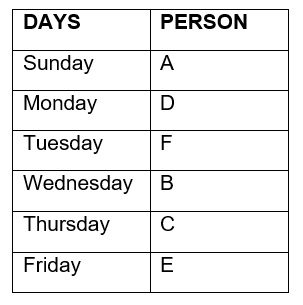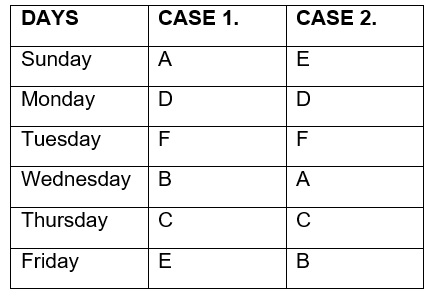Question
Six people, A, B, C, D, E, and F, went for exam, on
different days from Sunday to Friday, of the same week. How many persons went after B? Statement I: B went three days after A. Only one person went between B and E. E went after B. C went after F. D went before F. Statement II: Two persons went between D and C. Neither D nor C was the first and the last person to visit. F went two days before C. E did not went on Wednesday. B went after A. The question given below consists of two statements I and II given below it. You have to decide whether the data provided in the statements are sufficient to answer the question. Read all the statements and give answer.Solution
From statement I, B went three days after A. Only one person went between B and E. E went after B. C went after F. D went before F.  Two persons went after B. From statement II, two persons went between D and C. Neither D nor C was the first and the last person to visit . F went two days before C. E did not went on Wednesday. B went after A.
Two persons went after B. From statement II, two persons went between D and C. Neither D nor C was the first and the last person to visit . F went two days before C. E did not went on Wednesday. B went after A.  Either no person or two persons went after B. So, data in statement I alone is sufficient to answer the question and data in statement II alone is not sufficient to answer the question.
Either no person or two persons went after B. So, data in statement I alone is sufficient to answer the question and data in statement II alone is not sufficient to answer the question.
Interest payable on the bonds is a/an _______
What is the primary function of the Securities and Exchange Board of India (SEBI)?
When was the Government e-Marketplace (GeM) launched in India?
On Jan 1, 2017 the position of V. Mathur was as follows:
Inventory in hand Rs. 2400; Bills payable Rs. 400; Cash at Bank Rs. 1800;...
The primary function of Audit is:
(i) to verify the accuracy and completeness of accounts.
(ii) to secure that all revenue and receipts co...
Which function in MS Excel is used to find the present value of an investment?
Under what heading, "uncalled liability on partly paid up shares" will appear while preparing final accounts of limited liability companies?
In amalgamation in the nature of merger, which method is used?
In India, the GST is based on the dual model GST adopted in:
The Objective of ______ is to ensure that appropriate recognition criteria and measurement bases are applied to provisions and contingent liabilities an...
Relevant for Exams:


